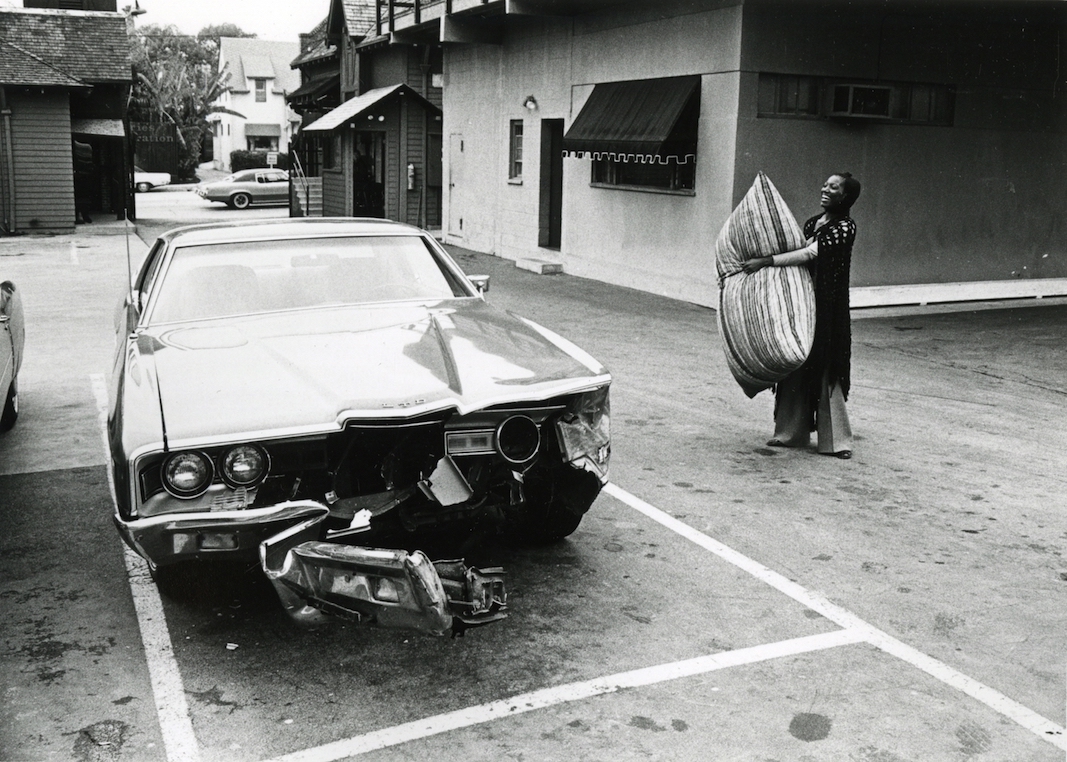A surreal, frenetic portrait of LA’s streets in the ‘70s
- Text by Miss Rosen
- Photography by Gary Krueger

American photographer Gary Krueger attributes his success to luck, chalking it up to an undeniable knack for being at the right place at the right time. After graduating high school in 1963, Krueger hopped in his 1954 Ford and drove west from his native Cleveland, Ohio, to Los Angeles to study graphic design and photography at Chouinard Art Institute, which later became the fabled California Institute of the Arts.
“I was one of four people in the ‘60s who didn’t take drugs that went to art school. I was the casual observer of what was going on,” Krueger says. “I’ve always had a camera, Brownie Starflash, but it was never anything serious. After I got into Chouinard, I made one print in the darkroom and went, ‘This is fucking magic!’ It knocked me out.”
After graduating in 1967, Krueger got a job working at the ‘Imagineering’ division of Disney to photograph the park and its events. “After six months, I decided I’m going to be a photographer,” he remembers.


Krueger quickly struck gold when he landed a cover for West magazine. “I got $250. Well, it might as well have been a million dollars! This is 1967. To give you an idea, gasoline was 11 cents a gallon. My rent was $55 a month.”
Self-employed since March 1968, Krueger has maintained a successful editorial and commercial photography career despite being “very unaggressive about selling my work. I was just glad to work. I’m good but extremely lucky that people call me back.”
And sometimes, they simply call out of the blue. Last autumn, Krueger received a call from gallerist Joseph Bellows asking if he was “the Gary Krueger that Camera magazine out of Switzerland did an article on in 1971.” Indeed, he was. “One thing led to another, and he gave me a show. That’s what I mean about being at the right place at the right time,” Krueger says.


In the new exhibition Gary Krueger’s City of Angeles, 1971-1980, Krueger takes us on a trip back in time, when the photographer was hanging out on Hollywood Boulevard, in downtown LA, attending parades, pageants, and Hollywood parties making pictures for himself.
“I don’t know what got me into street photography. It just happened. I can’t tell you why I take pictures but I can show you why I take pictures. I’m more calculated in my more contemporary work. I’m a graphic designer and this was the complete opposite. Street photos are like chaos. In design, less is more and this is a different story,” he says.
“All my street photos are shot with a 35mm lens on a 35mm camera. I don’t do zoom lens; I don’t get down on the ground and shoot like Elliott Erwitt at a dog. Everything is shot at eye level and they’re all horizontal. I just said to myself, that’s what I’m going to do.”
And so he did. Looking back at the 1970s, Kruger reveals, “I’m 75 and I don’t think the world is ever going to be as good as it was for us. I really think we lived in the Golden Age. It was a different world.”



Gary Krueger’s City of Angeles, 1971-1980 is on view at Joseph Bellows Gallery in La Jolla, CA, through March 19, 2021.
Follow Miss Rosen on Twitter.
Enjoyed this article? Like Huck on Facebook or follow us on Twitter.
You might like

Largest-Ever Display of UK AIDS Memorial Quilt Opens at Tate Modern
Grief Made Visible — Comprising hundreds of panels made by lovers, friends and chosen family, the UK AIDS Memorial Quilt returns in full for the first time since 1994 – a testament to grief, friendship and the ongoing fight against HIV stigma.
Written by: Ella Glossop

Green Day’s Billie Joe Armstrong tells ICE to “fuck off” in LA protest video
Saviors — The singer shared the post on Sunday, featuring the band’s recently released song ‘Fuck Off’ as its soundtrack.
Written by: Isaac Muk

In Medellín’s alleys and side streets, football’s founding spirit shines
Street Spirit — Granted two weeks of unfettered access, photographer Tom Ringsby captures the warmth and DIY essence of the Colombian city’s grassroots street football scene.
Written by: Isaac Muk

A new book explores Tupac’s revolutionary politics and activism
Words For My Comrades — Penned by Dean Van Nguyen, the cultural history encompasses interviews with those who knew the rapper well, while exploring his parents’ anti-capitalist influence.
Written by: Isaac Muk

On Alexander Skarsgård’s trousers, The Rehearsal, and the importance of weirdos
Freaks and Finances — In the May edition of our monthly culture newsletter, columnist Emma Garland reflects on the Swedish actor’s Cannes look, Nathan Fielder’s wild ambition, and Jafaican.
Written by: Emma Garland

We are all Mia Khalifa
How humour, therapy and community help Huck's latest cover star control her narrative.
Written by: Alya Mooro

